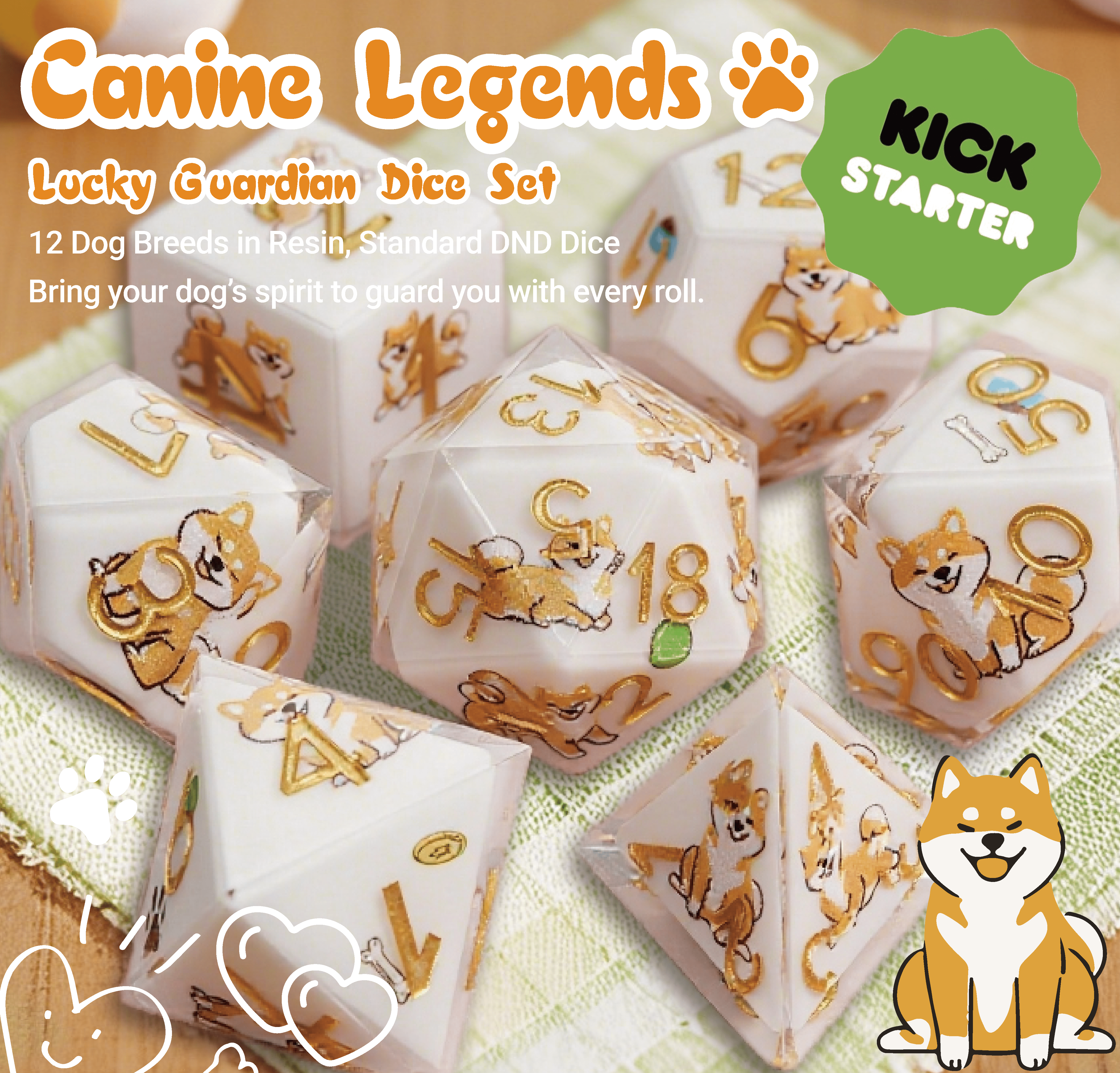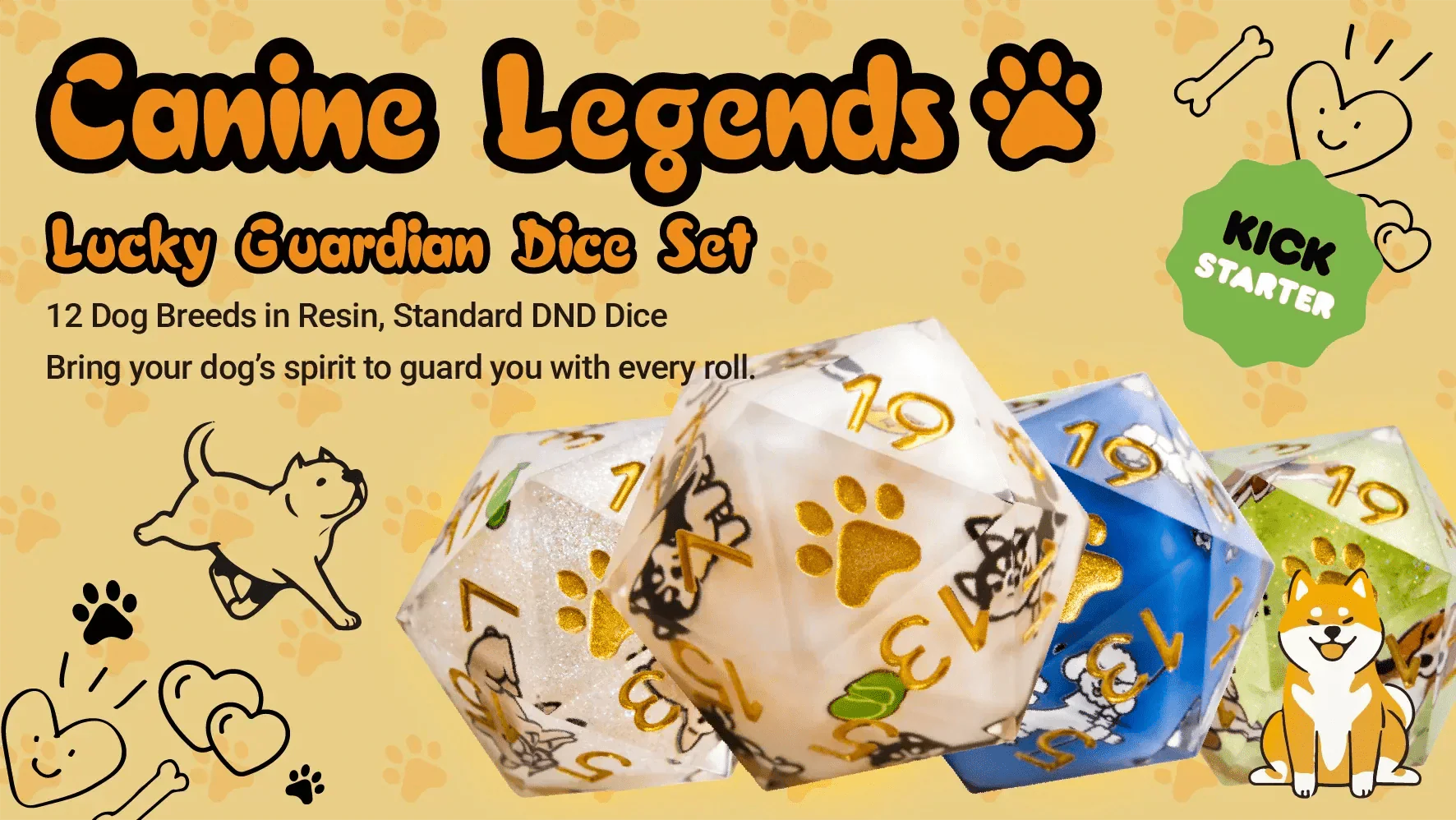Table of Contents
During an intense tabletop role-playing game, the DM suddenly says, "Roll a D100 to determine whether you successfully discover this hidden trap." You're taken aback, wondering if the D100 dice sets we often buy don't include them.
Not really. Common dice sets do include the D100, as they come in two forms: a single 100-sided die and a combination of two D10 dice representing percentages. Characters use D100 dice to make checks in many scenarios—for example, a rogue's Stealth check, a wizard's Knowledge check, or a fighter's Perception check. For this reason, D100 dice are particularly important in TRPGs.
This article will provide a comprehensive understanding of the D100 dice, including its history and purpose, how to roll it correctly, how to read the dice, and recommended D100 dice sets made of different materials.
1. What is a D100 Dice?
In RPG board games, dice are crucial tools for determining fate. Common dice include the D4, D6, D8, D10, D12, and D20, but the D100 dice holds the most special significance.
As the name suggests, a D100 dice has 100 sides, resembling a polyhedron approximately spherical, with each side engraved with a number from 1–100. It is often called a percentile dice because it can produce any result between 1 and 100, making it ideal for determining "percentage probability."
The significance of the D100 lies in its intuitive ability to express percentage probability. The roll ranges from 1 to 100, with each number corresponding to a 1% probability. Therefore, whether you have a "30% chance of success" or a "75% chance of finding treasure," you can determine the outcome directly with a single roll. It simplifies complex probability calculations and makes decisions in games fairer and more suspenseful.
Currently, there are two common ways to roll a D100:
- 1D100 dice—a physical, 100-sided dice printed with a random number from 1-100.
- 2D10 combination dice—two ten-sided dice, one representing the tens digit (00, 10, 20...90) and the other representing the ones digit (0-9), combined to produce a result from 1-100.
2. How to Roll a D100 Dice Correctly
Rolling a D100 dice is essentially the same as rolling regular dice. You simply:
- Shake the dice in your hand a few times;
- Roll it firmly onto the table or dice tray;
- Wait for it to come to a complete stop before reading the top number.
Whether using a D100 or 2D10 dice, it's recommended to roll in a dice tray. A dice tower is more suitable for rolling 2D10 dice, as the large size of the D100 dice makes it difficult to fit through the conventional entrance and intricate rolling tracks within the tower. This not only prevents the dice from rolling off the table, but also reduces noise, collisions, and human influence on the results.
3. How to Read a D100 Dice
1. Single D100 Dice
Reading a D100 dice is simple: simply read the number facing up, which ranges from 1 to 100.
2. Using 2D10 Dice Combination
This scenario is slightly more complex:
One D100 dice represents the tens digit (00-90), and the other D10 represents the ones digit (0-9).
For example, if you roll 70 (tens) and 3 (ones), the result is 73.
Special Case: If you roll 00 and 0, it represents 100, not 0.
This reading is very common in RPG systems like D&D and Call of Cthulhu. For more information on the special reading rules for the D100, please refer to our D10 Dice Reading Rules.
4. When to Use a D100 Dice
Many new players wonder, "Why use a D100 when a D20 already determines most outcomes?" Actually, the D100 has a wide range of uses. Here are some common scenarios:
1. Skill Checks
In games that rely on percentage systems, such as Call of Cthulhu, character skill scores are often expressed as percentages. For example, for "Detection 60%," the player simply rolls a D100, and a result of 60 or less is considered a success. This mechanism makes the decision process intuitive and easy to learn.
2. Random Events and Tables
Many RPG rulebooks provide "random tables," such as a 1–100 monster encounter table, a loot table, or a weather table. By rolling a dice, players or the host can quickly determine what happens, adding unpredictability and interest to the game.
3. Rare Items and Loot Drops
In fantasy or adventure games, the chance of a treasure drop isn't a simple success/failure, but rather a percentage. For example, there's a 5% chance of an artifact dropping, or a 40% chance of a rare potion. In these cases, a dice is a convenient tool, accurately reflecting these probability differences.
4. Special Determinations in Combat
In addition to the standard attack dice, some rules introduce percentages for critical hits or fumbles. For example, after a player lands a hit, they roll a D100. If the value falls within a certain range, a special effect is triggered. This makes combat more tense and exciting.
5. Large-Scale Probability Simulation
When a scenario requires simulating a large number of possibilities, the D100 is the perfect tool. For example, determining the outcome of a large-scale battle or how many people in a city of 10,000 will be affected. These macro-level decisions are difficult to make with small-faced dice, but the D100 easily handles them.
5. Rolling D100 Dice Online
If you don't have a physical D100 dice, don't worry. You can use our online tool, the Virtual D100 Roller, to quickly roll the D100 and get the result with a simple click. It's perfect for remote gaming or anytime, anywhere entertainment.
Using the Virtual D100 Roller helps us solve the following problems:
- Anytime Use - No need to carry physical dice. Easily roll at home, in the office, or on the go.
- Accurate and Fast - The system automatically generates random numbers from 1–100, eliminating the need for manual calculations or 2D10 combinations.
- Convenient Remote Play - In online multiplayer games, both the host and players can view results in real time, ensuring fairness.
- Record and Repeat Rolls - Quickly repeat the same roll, making it convenient for calculating probabilities or simulating multiple events.
- Eco-Friendly and Space-Saving - No need to worry about losing dice, and no physical space is required, making it perfect for tabletop game enthusiasts.
The Virtual D100 Dice Roller allows you to easily experience the fun of rolling a D100 anytime, anywhere, while maintaining a fair and smooth game experience. However, for most players, physical D100 dice still offer a more immersive and tactile feel. The tangible feel of rolling, the sound of rolling, and the visual effects are simply irreplaceable with virtual dice.
6. Variety of D100 Dice
Whether you're a seasoned player or a beginner, choosing the right D100 dice can greatly enhance your gaming experience. There are a wide variety of D100 dice available on the market, each with a unique feel and visual effect, making the throwing process more enjoyable and ceremonial. Here are some recommended D100 dice:
1. Metal Hollow D100 Dice
Metal D100 dice are stable and heavy, producing a crisp sound when rolled, offering players an exceptional tactile experience. Some hollow structures can be designed with 3D dragons or other characters, making the dice look stylish while also reducing weight and enhancing the clarity of the numbers. For players who collect or seek a high-quality feel, this type of dice is a perfect choice.
2. Translucent Acrylic D100 Dice
Translucent acrylic D100 dice are crystal clear, allowing the dice's natural color to shine through, making them a truly pleasing sight. Lightweight and easy to carry, with clearly readable numbers and smooth throwing.
3. Acrylic D100 Dice
The bright acrylic D100 dice feature rich colors and an opaque design that reduces light reflection, making the numbers easier to read and perfect for extended play.
4. Special 15-Piece D100 Dice Set
If you're looking for a complete dice experience, consider our Special 15-Piece D100 Dice Set. This set includes 1D3, 1D4, 1D5, 1D6, 1D7, 1D8, 1D10, 1D12, 1D14, 1D16, 1D20, 1D24, 1D30, and 1D100 dice, catering to different character types and play styles. Whether used for gaming or displayed as a collection, these sets are both practical and fun.
Whichever D100 dice you choose, they'll make rolls more realistic, checks more accurate, and enhance the overall immersion of the game. If you're looking for high-quality dice, browse our D100 dice for sale to find the right one for you.
7. Using a Dice Tray to Roll D100 Dice
While D100 dice bring fairness and excitement to board games, throwing them directly on the table can present some practical issues:
- A 100-sided dice is large and heavy, like a golf ball. It takes a long time to roll when thrown, and may even fall off the table, affecting fairness and the pace of the game.
- The large number of sides can also make reading difficult, especially in dim lighting or with complex dice designs. Quickly finding the result can be distracting.
- Large D100 dice, especially metal ones, can make a loud noise when thrown.
- Not adding a buffer zone to the dice can actually cause wear and tear on both the table and the dice themselves.
Therefore, we strongly recommend using a dice tray. It not only keeps the dice within a defined range but also provides a gentle landing, extending the life of your d100 dice.
8. Conclusion
Whether you're using D100 dice for skill checks, random events, rare loot drops, or complex probability simulations, they provide a clear and intuitive way to determine outcomes. Choosing the right D100 dice—whether metal, acrylic, translucent, or a full set—can enhance the tactile and visual experience of your game. Don't forget to use the dice tray!







